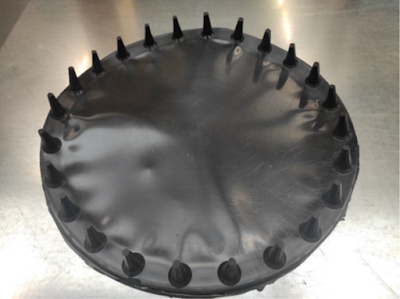Good practices and investments related to Cleaner Production
Example No. 18
Reducing rubber compound consumption while limiting the generation of vulcanization waste in the production of industrial couplings
Company:
Reich-cK Sp. z o.o., Bytom
Industry branch: manufacturing of rubber components
Main products: rubber-metal components – industrial couplings
Resources in question:
- Materials
- Waste
In one of the vulcanizing press mold, used to extrude rubber parts for the company's main product, AC10-type highly flexible couplings, unnecessary grooves (guide grooves) were noticed, the elimination of which would allow the company to consume less of the input material used in the production of the parts, without reducing the quality of the product.
Applied solution:
To eliminate the grooves guiding the mixture, the injection chamber was embossed in the mold. The appearance of the manufactured component before and after the change described here is shown in Figures 1 and 2. The mold modification was carried out at a third-party provider of metalworking and mold-building services. The change was made in the mold for the AC 10 series product, in all its configurations. The sustainability of the changes was ensured by updating the process in the process sheets and updating the machine control programs. The processes were supervised by team leaders and the quality control department.
Obtained benefits and effects of the implementation:
- Planned reduction in the consumption of rubber materials by about 300 g for each component produced, which will translate into about 1.5 Mg of material saved annually
- Planned reduction of the amount of waste generated (the recycling of which is not economically viable) by 1.5 Mg per year, which is almost 4% of all vulcanized rubber waste generated at the company, according to the 2021 volume
- Planned annual savings: PLN 31,725/year, including:
- from the reduction in material (rubber compound) consumption: PLN 30,375/year
- from the reduction in the amount of waste required for disposal: PLN 1,350/year
AC 10 mold flash before the described change (with guide grooves)
photo by Reich-cK Sp. z o.o., Bytom
photo by Reich-cK Sp. z o.o., Bytom
AC 10.2 mold flash after the introduction of the described change: the mold has virtually identical dimensions, but has no grooves
photo by Reich-cK Sp. z o.o., Bytom
Source:- Report on the Cleaner Production Project No. 7ind.788, developed within the framework of the Cleaner Production Academy at Reich-cK Sp. z o.o.: “Reducing rubber compound consumption while limiting the generation of vulcanization waste”
Polish version:
This
material has been subsidized by the National Fund for Environmental
Protection and Water Management. The Polish Cleaner Production Movement
Association is solely responsible for its content.








0 komentarze :
Prześlij komentarz